Back in 2005, three ex-PayPal employees had a simple idea: Make video sharing easy for everyone.
With just 10 slides and the line “Broadcast Yourself,” they raised $3.5 million from Sequoia. Bonkers, isn’t it?
One year later, Google bought the company for $1.65 billion. Today, YouTube is a global giant—but it all started with a clear pitch and perfect timing.
We’ll go through that original deck slide by slide—what they showed, what worked, and what every founder can learn from it.
Simple, bold, and still relevant
Let’s take a look at the actual slides from YouTube’s pitch deck first.
About YouTube (then vs. now)
When the pitch deck was created, YouTube had just launched—beta in May and officially in June 2005. It was a basic website that let users upload videos in different formats and stream them using Flash.
The three founders—Chad Hurley, Steve Chen —had just come from PayPal and brought strong tech credibility. At that time, online video was still a new and clunky experience.
YouTube had fewer than 10,000 users, but viral clips were spreading fast, and user engagement was growing quickly. They weren’t making money yet, but they had a working product and early traction.
That made them pitch-ready: strong team, real user interest, and perfect timing. The pitch raised $3.5 million in Series A funding to help them scale.
Today, YouTube is one of the biggest platforms on the internet. It’s owned by Google and serves over 2.5 billion users each month. Google itself is the second most-visited website in the world.
Users watch over a billion hours of video each day. The company brings in over $36 billion a year from ads and has added subscriptions and other revenue streams.
It also powers a huge creator economy, with more than 65 million creators and some earning tens of millions each year.
What started as a scrappy startup with a simple idea is now a global media powerhouse—and it all started with that first pitch deck.
Detailed YouTube pitch deck analysis (slide-by-slide)
This is a detailed breakdown of the original YouTube pitch deck, slide by slide. We’ll cover what each slide presents, what worked effectively, what fell short, and the key lessons founders can take away when building their own pitch decks.
Let’s begin.
1) Cover page

The slide shows just two things: the YouTube logo and the tagline “Broadcast Yourself.” No background, no design elements, no contact info.
I think that’s a confident choice. The tagline says exactly what the platform is for—and says it fast. It tells the user they’re in control, and that’s powerful. No need for extra words or clutter.
If I had to suggest one thing, maybe adding founder details would make it feel a bit more grounded. But overall, it’s a clear, direct opener.
Takeaway: A focused name and tagline can make a stronger first impression than a crowded slide.
2) Company purpose
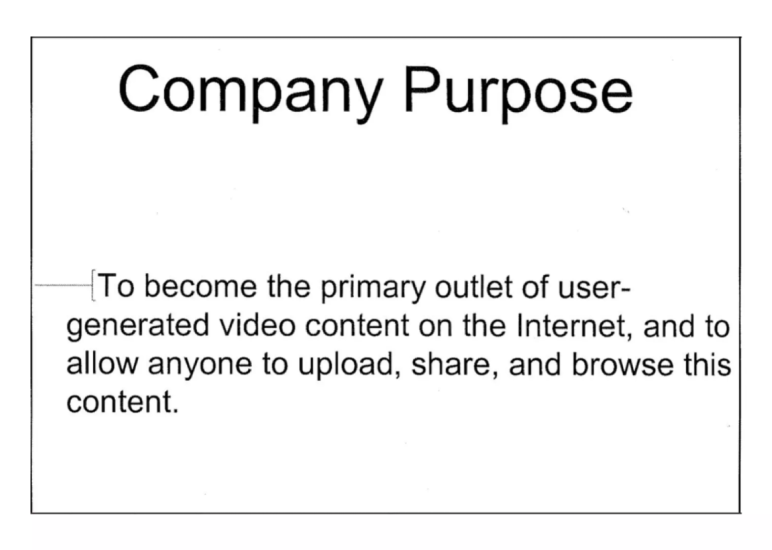
This slide spells out the goal in one line: To be the go-to platform for uploading, sharing, and watching user videos online.
I think it does the job well. It’s direct, easy to understand, and doesn’t try too hard. No fluff, just the core idea in plain words.
If anything, a tiny bit of context—like why this matters—could add weight. But as a quick intro, it works.
Takeaway: A clear, one-line purpose sets the tone fast and shows you know what you’re building.
3) Problem
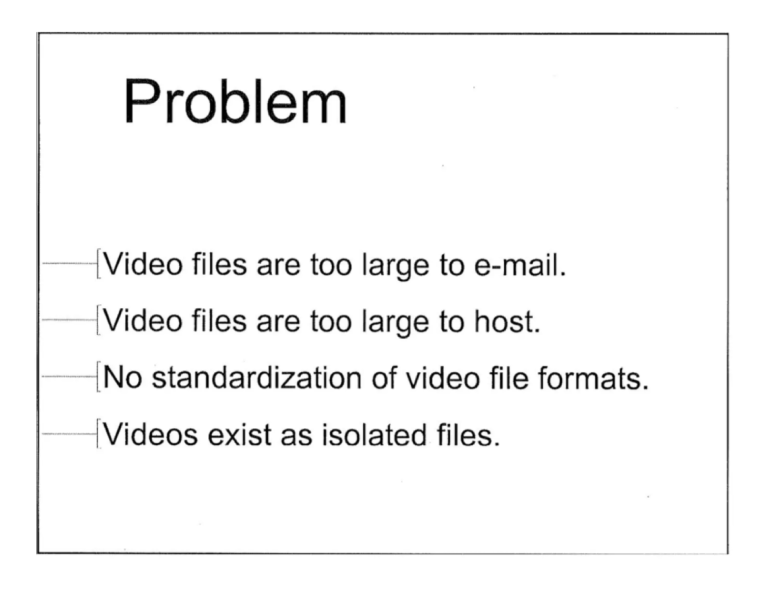
YouTube’s third slide points out the main issues people had with video sharing in 2005.
Video files were too big to email, too hard to host, came in different formats, and sat on people’s computers with no easy way to share or watch them. I remember this myself. Sending a video felt like a tech problem. Most people didn’t even try.
What I like here is how clear and direct the problem statement is. No need for visuals or stats—just a few lines that explain the problem in a way anyone can understand.
Takeaway: Talk about problems people already know. If they’ve felt it, they’ll get your pitch.
Ditch your old-school pitch deck creation methods
Make compelling pitch decks in minutes with AI
Plans starting from $14/month

4) Solution
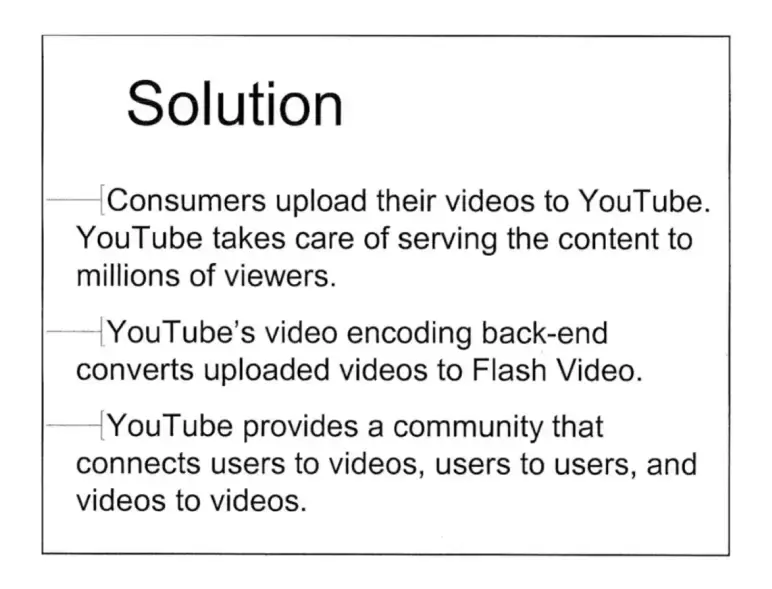
The solution slide shows how the product made video sharing easy. People could upload a video, and the platform handled the rest—hosting it, playing it, and making sure it worked.
I like that it also mentions the technical part. Instead of asking users to deal with file formats, everything was changed to Flash (a container file format used for delivering digital video content) so it could play anywhere.
It’s not just about the tech either. The idea was to create a place where people could share and connect through video.
Takeaway: A solid solution handles the technical work behind the scenes and keeps things simple for users.
5) Market size
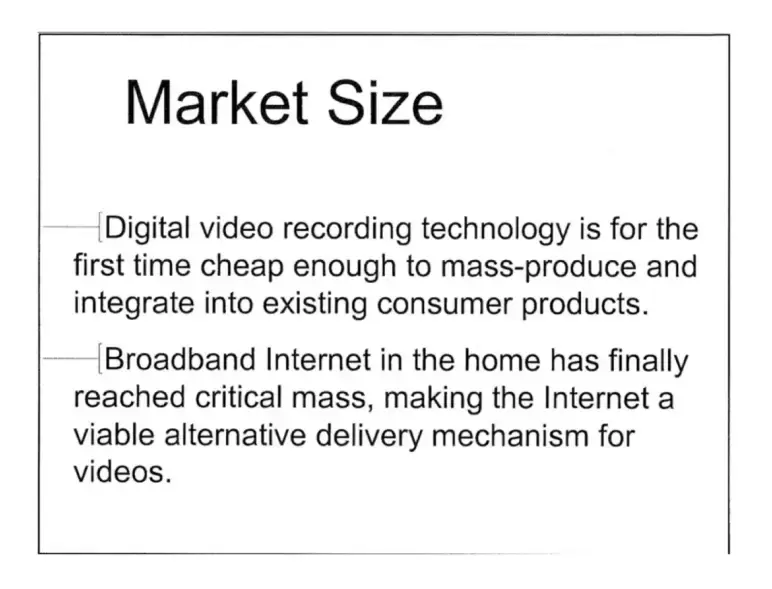
This slide explains why the timing made sense. Video cameras were affordable and built into everyday devices like phones and laptops, so more people were recording videos.
At the same time, internet speeds at home had improved, making it easier to upload and watch videos without delays.
I think it’s smart that the slide doesn’t rely on big numbers. It simply shows that the right tools were in place and people were ready for this kind of platform.
Takeaway: Make it clear what changed in the world that makes your idea possible today.
6) Competition

This slide lists other video platforms that were active at the time. It separates them into two groups: one with sites like OurMedia.org, Open Media Network, and Google Video; the other with PutFile, Dailymotion, and Vimeo.
All of them were trying to solve similar problems—letting people upload and watch videos online. There’s no direct comparison here, but it does show awareness of the space.
I think that works. It’s not about proving they’re better, just showing they knew who else was in the game.
Takeaway: Naming competitors shows you understand the market, even if you’re not doing a side-by-side comparison.
Ditch your old-school pitch deck creation methods
Make compelling pitch decks in minutes with AI
Plans starting from $14/month

7) Product development
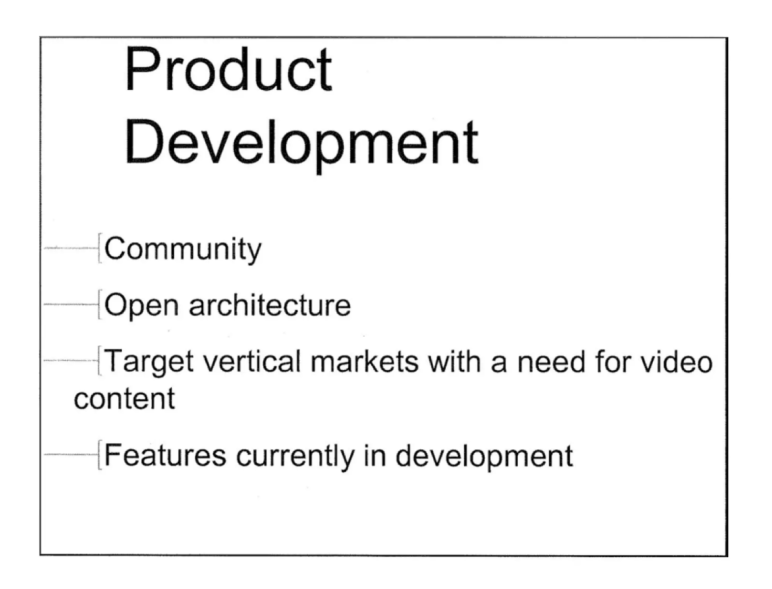
YouTube’s 7th slide talks about what was coming next. The idea wasn’t just to let people watch videos—it was to build a place where people could share, connect, and feel part of a community.
It also says the platform was open for developers, so others could build extra tools or features on top of it. That helps the product grow faster.
I like that they also planned to reach groups like schools and businesses, not just regular users. It shows they were thinking about more ways people could use the platform.
Takeaway: Show that your product has plans to grow and reach more people in different ways.
8) Sales & distribution
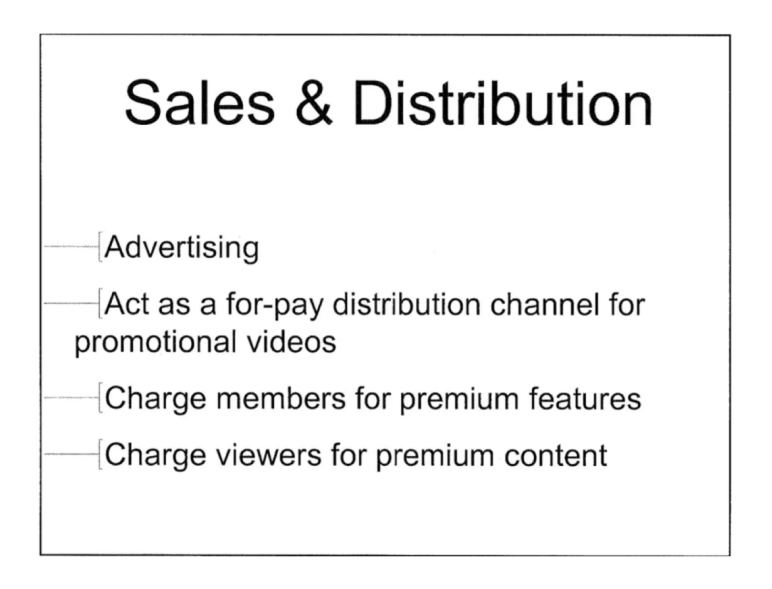
This slide lists ways YouTube planned to make revenue. The first idea was ads—brands would pay to show their products before or during videos.
The second was letting companies pay to upload their own promo videos, like using YouTube as a marketing channel.
They also mentioned paid features for users and charging for premium videos.
It’s not too detailed, but I think it works. It shows they had multiple ideas and weren’t relying on just one way to earn.
Takeaway: Even early on, showing a few clear revenue ideas helps build investor trust.
9) Team
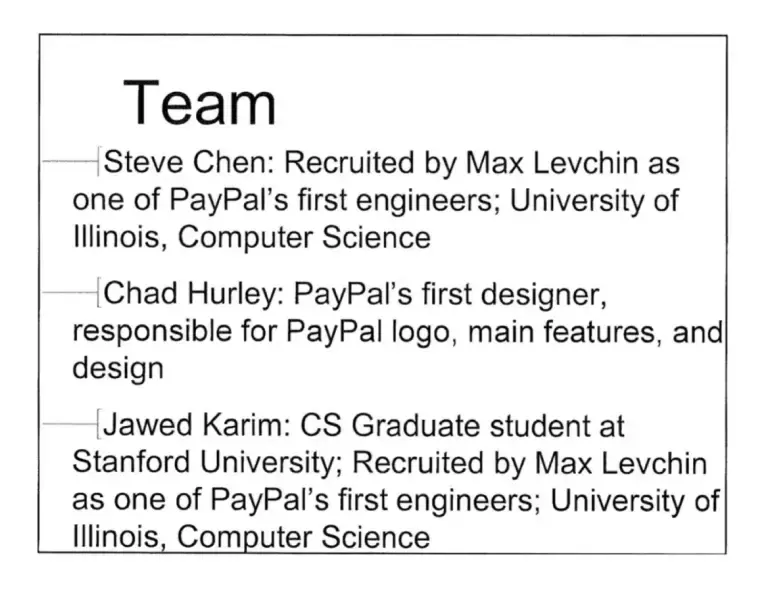
YouTube’s 9th slide gives a quick look at the founding team. Steve Chen is listed first—an early PayPal engineer with a strong tech background.
Chad Hurley was PayPal’s first designer. He worked on the brand and shaped how the product looked.
Jawed Karim was a Stanford student with an engineering background, also part of the PayPal team.
It’s short, but I think it works. The slide shows they weren’t just three random founders—they’d built serious things before.
Takeaway: A team with past experience at known companies gives investors confidence from the start.
Ditch your old-school pitch deck creation methods
Make compelling pitch decks in minutes with AI
Plans starting from $14/month

10) Metrics
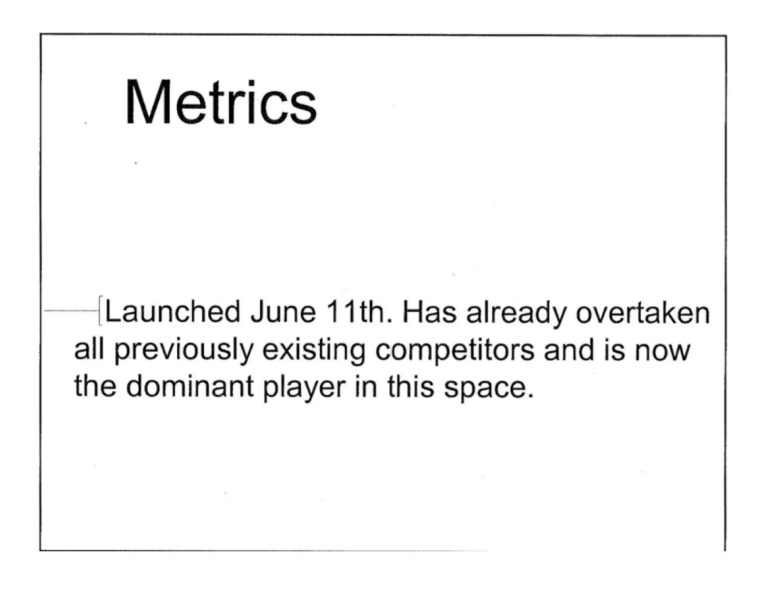
In this slide, they highlight how much progress has been made in a short time. The platform launched on June 11, and they’re already claiming to have passed every competitor.
There’s no chart or detailed data—but the message is clear: growth was happening fast, and they wanted investors to notice.
I think the bold tone works. It shows confidence without needing to show numbers.
Takeaway: If growth is real, even a clear statement can help show momentum early on.
What did I like the most about this deck?
I came to the conclusion that the team had real clarity on what they were building and why it mattered. It doesn’t try to impress with visuals—it just tells the story straight.
Here’s what I feel worked well:
- The problem is real and easy to relate to—video sharing used to be a pain.
- The solution is simple and clear, with no extra noise or features.
- They focused on timing, not just market size—and I think that worked better.
- Each slide flows into the next without losing clarity.
- The vision is bold but explained in just a few words.
- The team had strong experience from PayPal, and it shows.
- The traction slide feels confident, even without numbers or charts.
Overall, I think the deck worked well. It wasn’t perfect—some parts were light on detail—but it delivered the essentials: a clear problem, a timely solution, and a team that looked ready to build.
Perfect your deck and pitch using Upmetrics
After reviewing YouTube’s pitch deck, one thing is clear—your slides don’t need to be fancy. No clutter, no buzzwords. Just a real problem, the right timing, and a clear idea that makes sense.
That’s what got YouTube noticed—and that’s the kind of pitch investors want to see. If you’re building your own deck, Upmetrics can help.
Use our AI pitch deck generator to create a clean, investor-ready deck in minutes—no design skills needed.
Need expert support? Our pitch deck design services can help you refine your message, improve your slides, and get ready to pitch with confidence.

